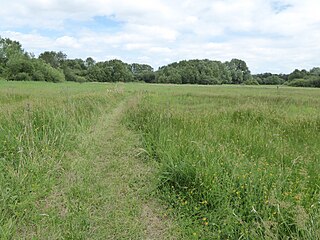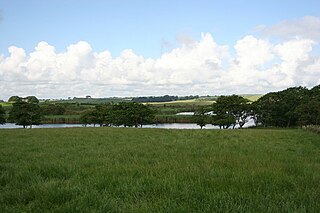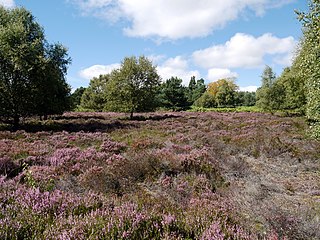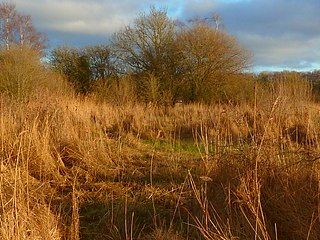Biological interest
The plant communities of the mire are nationally rare in Britain, and support two species, Black Bog-rush ( Schoenus nigricans ) and Blunt-flowered Rush ( Juncus subnodulosus ), that have restricted distributions in south-west England, and a number of species that are localised in the North Somerset area. Surrounding the raised mire is a belt of grassland; although this is included within the SSSI, it is largely made up of common grass and herb species.
In the community in the western part of the mire, Blunt-flowered Rush, Purple Moor-grass ( Molinia caerulea ) and Carnation Sedge ( Carex panicea ) are abundant species, and this part of the mire is characterised by the presence of a number of species that favour base-rich conditions. Black Bog-rush is locally abundant along a wet drainage ditch in this western part of the site. In the eastern part of the mire Purple Moor-grass and Blunt-flowered Rush are again abundant, but the abundant sedge species are Lesser Pond-sedge ( Carex acutiformis ) and Greater Pond-sedge ( Carex riparia ). Common Reed ( Phragmites australis ) and Marsh Horsetail ( Equisetum palustre ) are also frequent. This part of the site supports plant species associated with more neutral conditions.
The site has a species-rich flora; species that occur here but are localised or confined to specialised habitats in North Somerset are Flea Sedge ( Carex pulicaris ), Saw-wort ( Serratula tinctoria ), Meadow Thistle ( Cirsium dissectum ), Marsh Valerian ( Valeriana dioica ), Dyer’s Greenweed ( Genista tinctoria ), Marsh Arrowgrass ( Triglochin palustris ), Southern Marsh-orchid ( Dactylorhiza praetermissa ), Fen Bedstraw ( Galium uliginosum ), Devil’s-bit Scabious ( Succisa pratensis ) and Tawny Sedge ( Carex hostiana ) and Tufted-sedge ( Carex elata ).

Gordano is an area of North Somerset, in England. It has been designated as a National Nature Reserve.

The North Somerset Levels is a coastal plain, an expanse of low-lying flat ground, which occupies an area between Weston-super-Mare and Bristol in North Somerset, England. The River Banwell, River Kenn, River Yeo and Land Yeo are the three principal rivers draining the area.

Windsor Hill Marsh is a 0.84 hectare biological Site of Special Scientific Interest, north of the town of Shepton Mallet in Somerset, and adjacent to the Windsor Hill Quarry geological Site of Special Scientific Interest. It was notified in January 1972.

Lambert's Castle is an Iron Age hillfort in the county of Dorset in southwest England. Since 1981 it has been designated as a Site of Special Scientific Interest (SSSI) on account of its geology, archaeology and ecology. The hillfort is designated a scheduled monument together with a bowl barrow, the sites of a post-medieval fair and a telegraph station.
NVC community H5 is one of the heath communities in the British National Vegetation Classification system. It is one of three communities which are considered transitional between the lowland dry heaths and the wetter communities classified in the NVC as mires.

Scotstown Moor is in the north of Aberdeen, Scotland.

Purple moor grass and rush pastures is a type of Biodiversity Action Plan habitat in the UK. It occurs on poorly drained neutral and acidic soils of the lowlands and upland fringe. It is found in the South West of England, especially in Devon.

Hisehope Burn Valley is a Site of Special Scientific Interest in the Derwentside district of Durham, England. It consists of two separate parcels of land, one on the west bank of Hisehope Burn, the other a few hundred yards to the east, straddling the headwaters of another small burn. The site is some 3 km west of the village of Castleside and 1 km north of the Smiddy Shaw Reservoir. The larger area adjoins the Muggleswick, Stanhope and Edmundbyers Commons and Blanchland Moor SSSI.

Pow Hill Bog is a Site of Special Scientific Interest in the Wear Valley district of County Durham, England. It lies alongside Derwent Reservoir, approximately 2 km north-west of the village of Edmundbyers and adjacent to the Edmundbyers Common portion of the Muggleswick, Stanhope and Edmundbyers Commons and Blanchland Moor SSSI.

Blo' Norton and Thelnetham Fens are a 21.3 hectare biological Site of Special Scientific Interest (SSSI) on the Norfolk/Suffolk border. Blo' Norton Fen is in the parish of Blo' Norton in Norfolk and Thelnetham Fen is in Thelnetham parish in Suffolk. It is a Nature Conservation Review site, Grade 2, and part of the Waveney and Little Ouse Valley Fens Special Area of Conservation, Thelnetham Fen is managed by the Suffolk Wildlife Trust and Blo' Norton Fen by the Little Ouse Headwaters Project (LOHP).

Llyn Bodgylched is a Site of Special Scientific Interest in Anglesey, North Wales, to the west of Beaumaris. It has been designated as a Site of Special Scientific Interest since January 1968 in an attempt to protect its fragile biological elements, mainly a swamp. The site has an area of 16.37 hectares and is managed by Natural Resources Wales.
Chyenhal Moor is a poorly drained shallow valley, 2 miles (3.2 km) to the south-west of Penzance, Cornwall. Due to several rare plants in a diverse range of habitats, it was notified as a Site of Special Scientific Interest (SSSI) in 1951.

Allendale Moors is a Site of Special Scientific Interest (SSSI) in Northumberland, England. The upland moorland ridge site is listed for its heath, flush and upland grassland which provide a habitat for a nationally important assemblage of moorland breeding birds.

Bewick and Beanley Moors is the name given to a Site of Special Scientific Interest (SSSI) in north Northumberland, in the north-east of England. The moors are asserted to be of national importance by Natural England for the extent, quality and diversity of upland types including heaths, fens, wet grassland, flushes, mires and blanket bogs, together creating an extensive mosaic habitat supporting an exceptional community of amphibians. The moors are important, too, for their relict juniper woodland and scrub.
Fallowlees Flush is the name given to a Site of Special Scientific Interest (SSSI) in mid-Northumberland, England. The steeply sloping site has calcium-rich springs supporting vegetation rare in the county.

Salta Moss is a raised blanket mire which is a Site of Special Scientific Interest ('SSSI') located in the hamlet of Salta, in Cumbria, United Kingdom. It was determined to be of biological interest under the Wildlife and Countryside Act 1981. The site, measuring 45.6 hectares, was officially designated in August 1982.

Farnham Mires is a Site of Special Scientific Interest, or SSSI, to the east of the village of Farnham, North Yorkshire, England. It consists of a spring-fed marshy fen or mire with reeds and sedge, and drier calcareous grassland containing a diverse range of flora. It has a history of poaching and fox hunting, but since the late 19th century, the attention of botanists has been drawn to its large variety of flowering plants. It has received some consideration on this account since 1944, and from 1954 it was designated SSSI status. This site has no facilities, and is not open to the public.

Cow Myers is a Site of Special Scientific Interest (SSSI) located in the Nidderdale Area of Outstanding Natural Beauty (AONB), near Ripon, North Yorkshire, England. The site was designated in 1984 for its fen and alder carr habitat, which supports a diversity of wetland plant life. Of particular interest are the bird's eye primrose which is scarce in Yorkshire, and early marsh orchid. There is no public access to this site, no vehicular access, and no public facilities.

Bishop Monkton Ings is a Site of Special Scientific Interest, or SSSI, situated east of Bishop Monkton village in North Yorkshire, England. It consists mostly of marshy, calcareous grassland, with some broadleaved woodland, and some fen alongside the two watercourses which run through the site. This varied wetland forms a habitat for a variety of plants, including the semi-parasitic marsh lousewort (Pedicularis palustris).

Mar Field Fen is a Site of Special Scientific Interest, or SSSI, north of Masham, North Yorkshire, England, in a rural area known as Marfield. It is situated on land containing woodland carr, fen, spring-fed marshy grassland and drier calcareous grassland, between the River Ure to the east and Marfield Wetland nature reserve to the west. As "one of the best examples of fen habitat in the Vale of York," it is a protected habitat for a variety of plants, including the common butterwort, a carnivorous plant. There is no public access to this site.

















